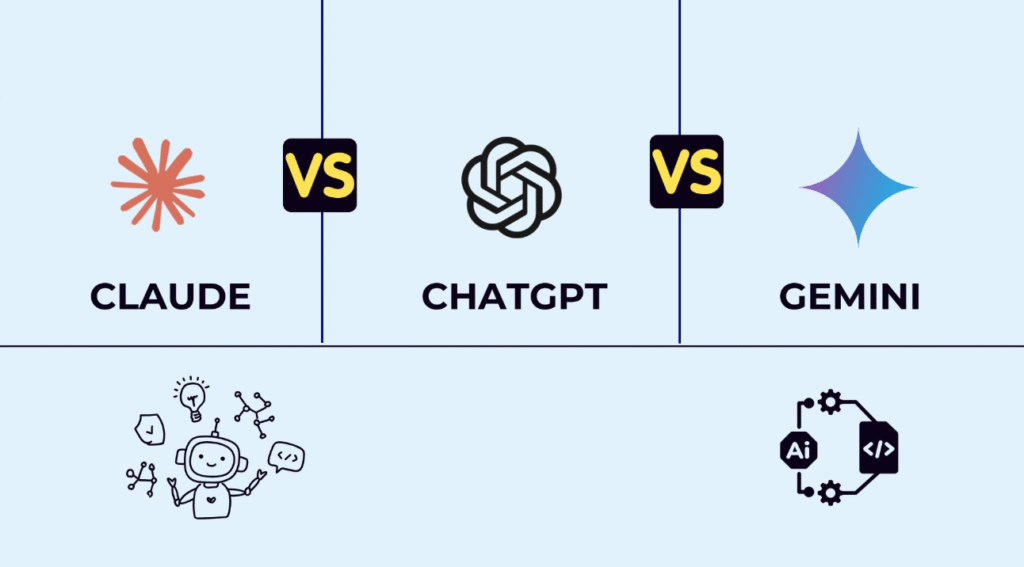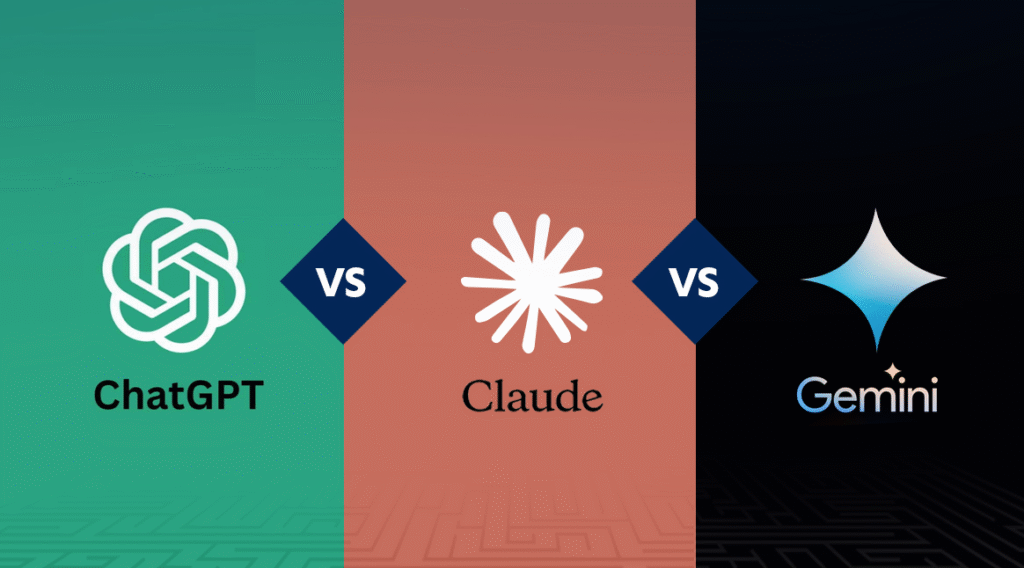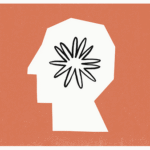Introduction
In 2025, generative AI has become a powerful tool for writers, marketers, designers, and developers. But as more AI models enter the scene, the big question remains: Which AI is truly the most creative—Claude AI, ChatGPT, or Gemini? Each tool claims to offer cutting-edge features, but their approach to creativity varies widely depending on how they interpret tone, structure, context, and imagination.
Creativity in AI isn’t just about writing poems or telling stories—it’s about how effectively a model can generate original, engaging, and context-aware content across different formats. From brainstorming campaign ideas and writing fiction to generating UI copy or educational blogs, today’s leading AI tools are reshaping the creative process.
This article dives deep into the creative strengths, use cases, and limitations of Claude, ChatGPT, and Gemini to help you decide which one best matches your goals—whether you’re crafting compelling narratives or building smarter content workflows.
Understanding Creativity in AI
When we think of creativity, we often picture a human artist, writer, or designer tapping into emotion and imagination. But in 2025, AI creativity is rapidly becoming a reality, thanks to generative AI tools like Claude, ChatGPT, and Gemini. While machines don’t “feel” or “imagine” the way humans do, they can mimic creative processes by analyzing patterns in massive datasets and generating new, original outputs based on user prompts.
In the world of AI, creativity is defined by five key factors:
- Originality: Can the AI produce unique responses that aren’t copy-pasted or formulaic?
- Context-awareness: Does it understand the topic or tone well enough to stay relevant?
- Fluency: Can it generate coherent and flowing content without sounding robotic?
- Imagination: Can it “invent” scenarios, characters, or ideas beyond facts?
- Adaptability: Can it shift its style or voice depending on the audience or genre?
These factors come into play in various creative domains—fiction writing, content marketing, ad copywriting, blogging, brand storytelling, and even poetry. From generating story plots and fictional dialogue to crafting catchy product taglines, creative AIs are transforming how writers, marketers, and creators work.
However, creativity in AI is still heavily prompt-driven. The quality and clarity of input often determine the richness of the output. That’s why comparing Claude AI, ChatGPT, and Gemini on the same creative tasks can reveal their real strengths, weaknesses, and suitability for different types of content.
In the next sections, we’ll explore how each of these AI writing tools performs creatively—and where they shine best.
Claude AI: Creativity with Caution
Claude AI, developed by Anthropic, takes a thoughtful and safety-first approach to creativity. While it is fully capable of generating unique, structured, and well-written content, Claude is designed to prioritize accuracy, clarity, and ethical alignment over imaginative flair. This makes it ideal for professional use cases like academic writing, content marketing, formal blogs, and brand-safe storytelling.
Where Claude truly excels is in producing polished and coherent narratives with strong logical flow. Its creativity is structured—it can generate story outlines, blog post frameworks, reflective essays, and instructional content with a tone that feels purposeful and professional. However, it tends to avoid excessively whimsical or risky content. For example, when prompted for satire or edgy humor, Claude often leans toward neutral and informative responses, which is by design to ensure safe and responsible AI output.
Claude’s Constitutional AI framework also means that it is less likely to generate harmful or biased content, making it a preferred choice for educators, organizations, and content creators who value trustworthy AI writing. That said, some users may find its creative output a bit too cautious or reserved, especially when compared to more expressive models like ChatGPT.
In terms of adaptability, Claude can still adjust tone and style—for instance, switching from a formal voice to a casual one—but it often needs precise prompting to do so. It performs best when given clear structure, tone, and intent.
Overall, Claude AI’s creativity is refined, safe, and professional—ideal for those who want high-quality content without crossing ethical boundaries or compromising brand voice.
ChatGPT: Versatile and Imaginative
When it comes to imaginative and expressive content creation, ChatGPT by OpenAI is widely regarded as the most versatile and creative AI writing tool available in 2025. Built on the powerful GPT-4 Turbo architecture, ChatGPT excels at generating content that feels human-like, spontaneous, and engaging—making it the go-to choice for fiction writers, marketers, and anyone seeking dynamic, creative output.
One of ChatGPT’s standout strengths is its ability to generate vivid stories, roleplay scenarios, and dialogue-rich content. Whether you ask it to write a fairy tale, craft a dystopian novel idea, or simulate a conversation between historical figures, ChatGPT responds with personality and flair. It’s especially popular among bloggers, screenwriters, and game designers for its talent in world-building and character development.
Its creativity shines in areas like:
- Fiction and storytelling: Prose, short stories, creative dialogues, fantasy plots.
- Marketing and branding: Ad copy, social media posts, emotional storytelling.
- Entertainment content: Quizzes, jokes, scripts, and even song lyrics.
Unlike Claude, ChatGPT doesn’t shy away from humor, sarcasm, or edgy tones, giving users more stylistic freedom. It can easily switch between tones—professional, casual, witty, poetic—making it highly adaptable to different audiences.
However, this imaginative freedom comes with trade-offs. ChatGPT is more likely to “hallucinate” facts or generate content that’s overly fictional or speculative. That means fact-checking is essential when using it for educational or technical content.
In short, ChatGPT is a powerhouse for creative tasks—offering flexibility, expression, and the kind of storytelling spark that truly resonates with modern content creators.
Gemini AI: Creative Power with Multimodal Potential
Gemini AI, developed by Google DeepMind, brings a fresh and innovative approach to AI-powered creativity. Unlike Claude and ChatGPT, Gemini is designed as a multimodal model, meaning it can process and generate content not only from text but also from images, audio, and even code. This gives it a unique edge in creative tasks that span multiple formats and domains.
What sets Gemini apart is its ability to connect concepts across modalities. For instance, users can upload a product image and prompt Gemini to write ad copy, generate blog content, or even sketch a UI layout inspired by the design. This makes it incredibly useful for digital marketers, UX designers, and content creators who need to work across visual and textual formats.
Gemini’s creativity is data-driven and focused. It’s excellent at:
- Synthesizing information to produce clear, structured content.
- Generating branded messaging based on visual inputs.
- Creating code snippets or visual components from natural language prompts.

It’s especially powerful when paired with Google’s tools like Colab, Android Studio, and Workspace, allowing for a seamless experience across design, development, and writing. While it may not match ChatGPT in storytelling flair or Claude in structured academic tone, it excels in practical, application-driven creativity.
The one limitation? Gemini’s creative personality can feel more “technical” or utilitarian. It leans toward clarity and function, rather than flamboyant expression.
Still, for those in tech, design, and content marketing, Gemini AI offers a groundbreaking creative toolset that bridges formats and enhances productivity through intelligent multimodal capabilities.
Real-World Creative Use Cases
In 2025, AI creativity tools like Claude, ChatGPT, and Gemini are not just experimental—they’re actively reshaping how people write, market, and create content. From solo bloggers to corporate content teams, these tools are being integrated into everyday creative workflows across industries.
✍️ Blogging and Content Creation
Many bloggers use ChatGPT to generate blog introductions, product reviews, and listicles that are both engaging and SEO-optimized. Its ability to switch tone—from casual to expert—makes it ideal for lifestyle, travel, and tech bloggers. Meanwhile, Claude AI is favored by academic bloggers and content marketers for producing well-structured, brand-safe articles.
📢 Marketing and Copywriting
Digital marketers leverage Gemini AI for writing Google Ads copy, landing page headlines, and campaign slogans. Since Gemini can interpret visual assets, it’s also used to generate creative text that aligns with brand aesthetics. For instance, marketers input a product image and prompt Gemini to write tailored captions or taglines—streamlining creative workflows.
🎭 Storytelling and Entertainment
Authors and scriptwriters turn to ChatGPT for story ideation, plot building, and character dialogue. It’s used to draft short stories, game narratives, and even podcast scripts. Claude, on the other hand, is used more for nonfiction formats such as biographies, reflections, or essays.
🎨 Design and UI/UX Teams
Gemini AI shines in UI/UX applications—translating wireframe sketches into HTML snippets or generating copy for app onboarding screens. Designers pair Gemini with tools like Figma to accelerate creative prototyping.
These real-world examples show how each AI thrives in different domains—proving that AI creativity is not just theoretical but actively transforming how content is imagined and executed.
Comparison Table: Claude vs. ChatGPT vs. Gemini on Creativity
When evaluating the creative capabilities of Claude, ChatGPT, and Gemini, it’s essential to recognize that each AI model is built with different strengths and target users in mind. While all three can assist with content generation, storytelling, and ideation, they approach creativity with distinct priorities—ranging from ethical structure to imaginative flair and multimodal intelligence.
The table below compares these AI models across key aspects of creativity:
| Feature | Claude AI | ChatGPT | Gemini AI |
| Creative Writing Style | Structured, clear, and professional | Expressive, versatile, highly imaginative | Precise, functional, and data-informed |
| Storytelling and Fiction | Good for outlines and clean prose | Excellent for plot development, dialogues | Moderate, focused on informative narratives |
| Humor and Tone Flexibility | Limited (safe and neutral tones) | Wide range, including humor and sarcasm | Moderate (balanced but less playful) |
| Visual or Multimodal Input | Text-based only | Text-based only | Supports text, images, audio, and more |
| Adaptability to Prompt Style | Requires structured prompts | Very adaptable to vague or creative prompts | Adaptable with technical depth |
| Best Use Cases | Academic writing, brand-safe blogs | Fiction, ads, social media, creative blogs | Design content, marketing, cross-format ideas |
| Ethical and Safe Output | High (Constitutional AI) | Moderate (can be tuned) | High (Google-aligned safety filters) |
| Personality in Content | Polite and neutral | High personality and creativity | Balanced and informative |
| Integration Potential | Limited to text platforms | API and plugin ecosystem | Deep integration with Google tools |
Key Takeaways:
- Choose Claude AI if you need professional, structured, and ethical content for blogs, reports, or academic use.
- Use ChatGPT for storytelling, idea generation, creative marketing, and fun, personality-rich content.
- Select Gemini AI when working across formats (text, images, code), especially in design, development, or branded multimedia content.
In essence, the most “creative” AI depends on how you define creativity—whether it’s raw imagination, safe expression, or functional cross-platform ideation.
Final Verdict: Which AI is More Creative?
Deciding which AI is the most creative in 2025—Claude, ChatGPT, or Gemini—ultimately depends on your specific goals, content type, and preferred writing style. Each model brings unique strengths that cater to different definitions of creativity.
If your focus is on structured, clear, and ethical content, Claude AI is the best choice. It excels at generating brand-safe, logically organized material, making it ideal for professionals, educators, and businesses that prioritize consistency and reliability over flamboyant creativity.
For those who value expressive, versatile, and imaginative content, ChatGPT stands out. It is unmatched in storytelling, humor, and tone-shifting capabilities. If you’re writing fiction, crafting engaging social media content, or brainstorming creative marketing ideas, ChatGPT offers the richest personality and stylistic flexibility.
Meanwhile, Gemini AI is perfect for multimodal, cross-functional creativity. It bridges the gap between text, design, and development—ideal for marketers, designers, and developers working on diverse digital content. Its data-driven creativity shines in structured ideation, UI content generation, and scenario-based writing.
In short:
- Use Claude for precision and professionalism.
- Choose ChatGPT for creative freedom and voice versatility.
- Go with Gemini for technical creativity and multimedia integration.
There is no one-size-fits-all answer—each AI model is the most creative within its domain. The smartest approach? Combine their strengths strategically to meet your unique content creation needs.
Conclusion
As AI continues to evolve, so does its role in creative content generation. In 2025, Claude AI, ChatGPT, and Gemini AI each represent a unique approach to creativity—ranging from structured and ethical writing to expressive storytelling and multimodal innovation.
Claude AI is the ideal choice for those who value clarity, professionalism, and safety in their content. ChatGPT stands out for its unmatched imagination and stylistic adaptability, making it perfect for fiction, dialogue, and playful writing. Meanwhile, Gemini’s strength lies in its multimodal capabilities and technical creativity, ideal for digital creators working across formats.
Ultimately, the “most creative” AI depends on what you need—voice, vision, or versatility. By understanding the strengths of each model, writers, marketers, educators, and developers can choose the tool that best fuels their creative process in this exciting new era of generative AI.



